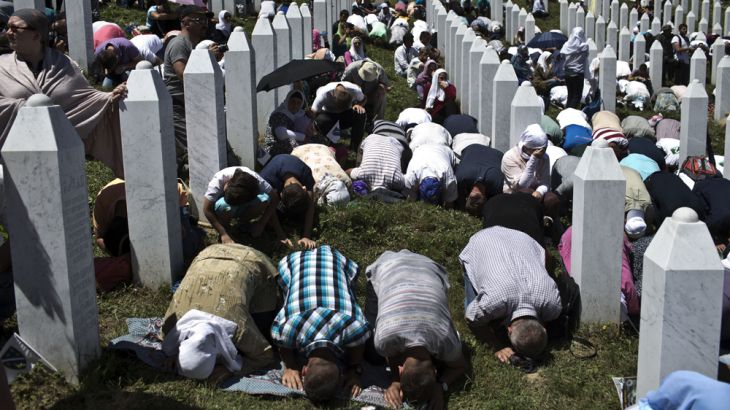Remembering Srebrenica, two decades on
Thousands of mourners descend on town where more than 8,000 Muslim men and boys were slaughtered during Bosnian war.

Tens of thousands of people poured into Srebrenica 20 years after more than 8,000 people were killed in the worst atrocity on European soil since World War II.
The remains of 136 newly-identified victims will be laid to rest on Saturday along with thousands of others already buried at a memorial centre just outside the Bosnian town.
Thousands of Muslim men and boys were killed by Bosnian Serb forces after they captured Srebrenica in July 1995 near the end of Bosnia’s inter-ethnic wa.
Serbian PM mobbed
Dozens of dignitaries from across Bosnia and abroad, were present at the ceremony and a day of mourning will be observed throughout the Balkan country.

Former US President Bill Clinton, whose administration brokered the Dayton peace deal that ended Bosnia’s 1992-1995 war only a few months after the Srebrenica killings, travelled to Srebrenica for the memorial.
The bones of newly identified victims will be interred beneath marble gravestones in the Potocari memorial cemetery, in what has become annual ritual as more graves are discovered.
“One cannot describe with words how I feel today,” said Zijada Hajdarevic as she escorted the remains of her brother on Thursday from the morgue to the cemetery, where her grandfather and other close relatives are all buried.
“We knew he was gone, but it will be easier now we know where we can visit his grave,” said Hajdarevic, who is still searching for her father.
Disputed term
A UN court has ruled that the killings in Srebrenica was genocide.
Many Serbs dispute the term, the death toll and the official account of what went on – reflecting conflicting narratives of the Yugoslav wars that still feed political divisions and stifle progress toward integration with Western Europe.
Bosnia still digging up its tortured past
Bosnian Serb leader Milorad Dodik last month described Srebrenica as “the greatest deception of the 20th century”.
Russia this week vetoed a UN resolution last week that would have condemned the denial of Srebrenica as genocide. Moscow called for all people responsible for the massacre to be brought to justice.
|
|
Samantha Power, Washington’s ambassador to the United Nations who was a 24-year-old journalist in Bosnia at the time, said: “You cannot build reconciliation on the denial of genocide.”
Ever since the massacre, the West has faced questions over how it allowed the fall of Srebrenica, a designated UN “safe haven” for Muslims Bosniaks displaced by the war.
Months later, NATO air strikes forced the Serbs to the negotiating table. A US-brokered peace treaty ended the fighting and enshrined in Bosnia a complicated and unwieldy system of ethnic power-sharing that survives today.
The accused chief architects of the massacre – Bosnian Serb wartime political leader Radovan Karadzic and military commander Ratko Mladic – remain on trial at a UN court in The Hague, protesting their innocence.